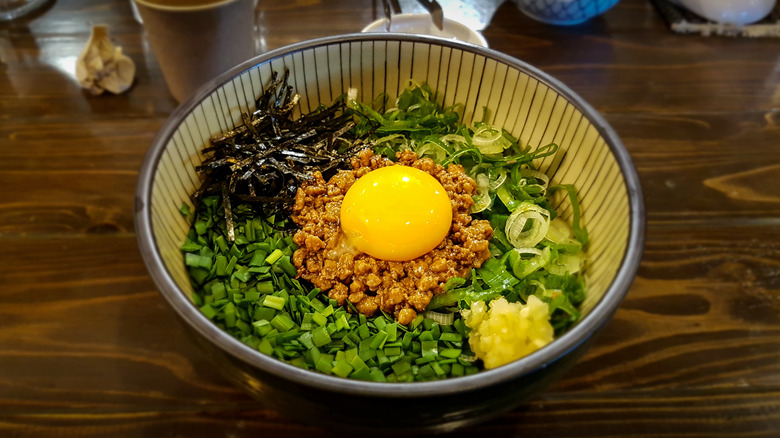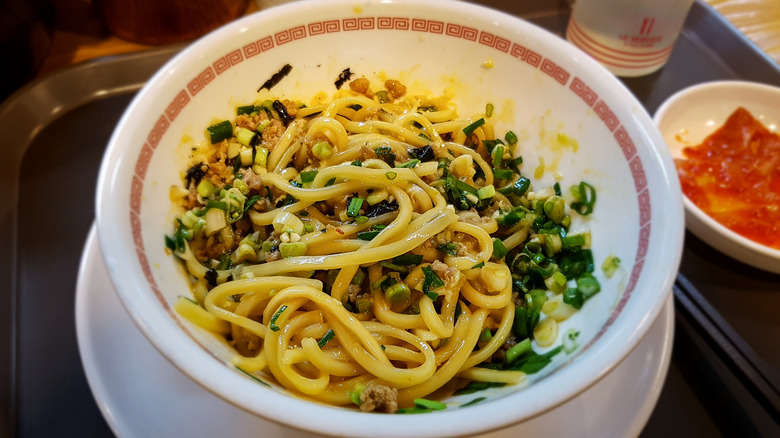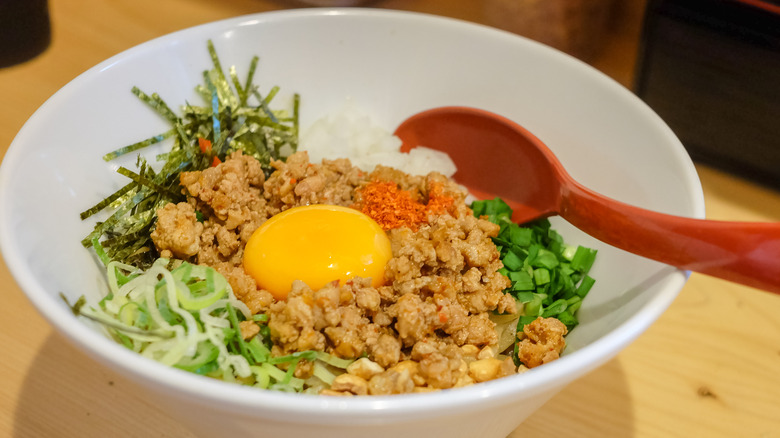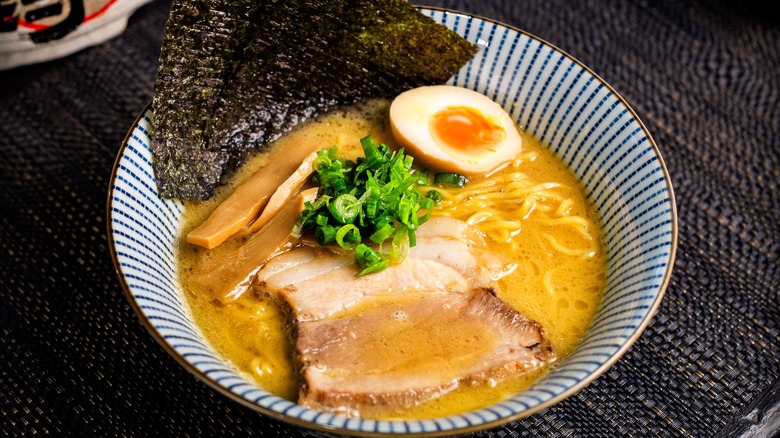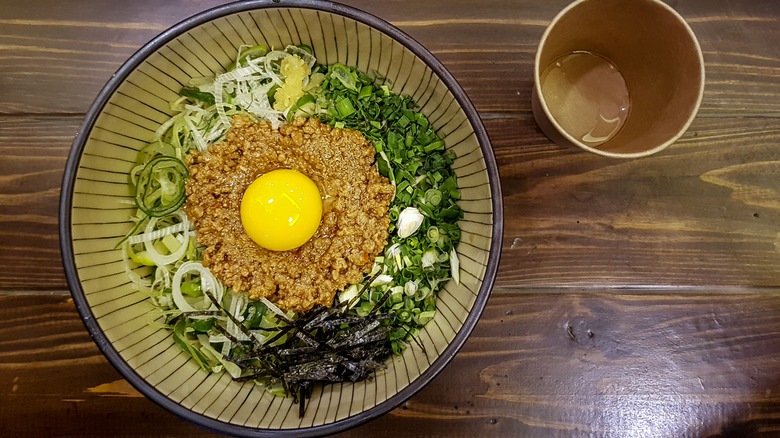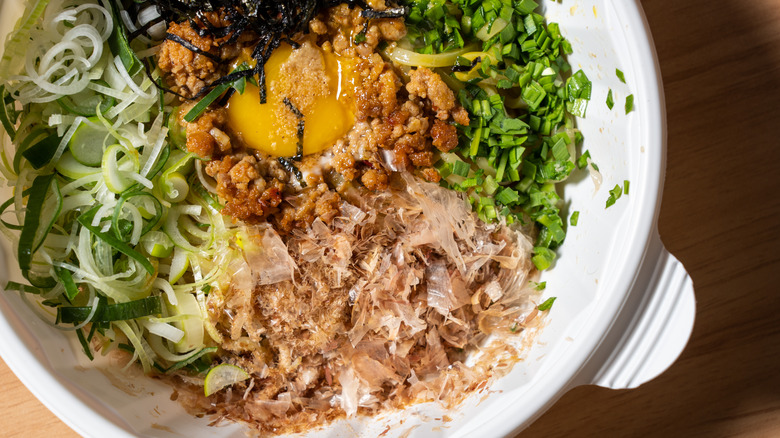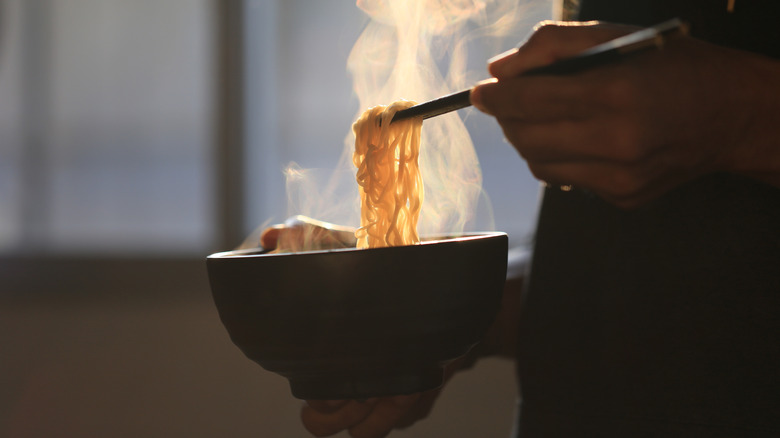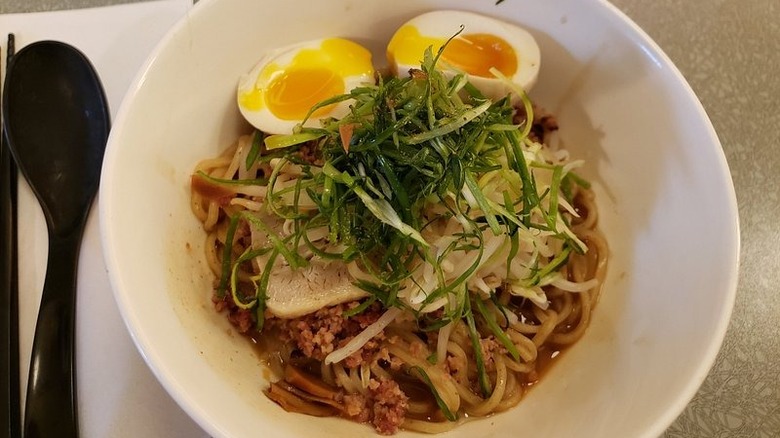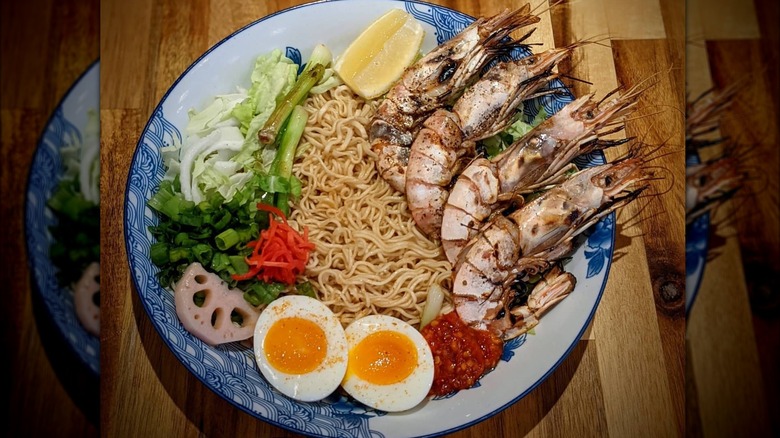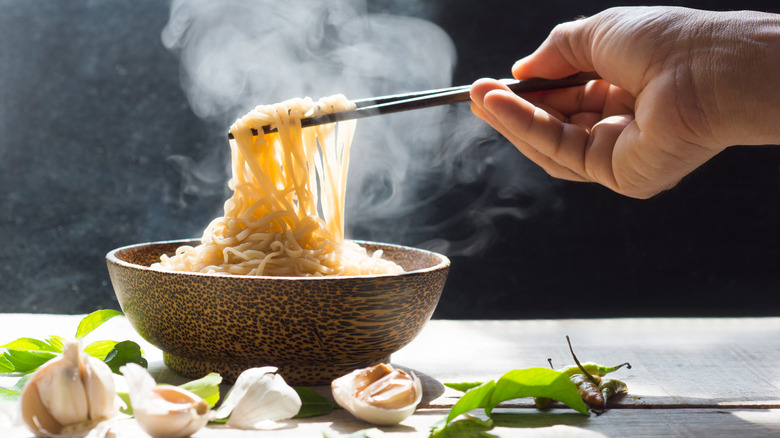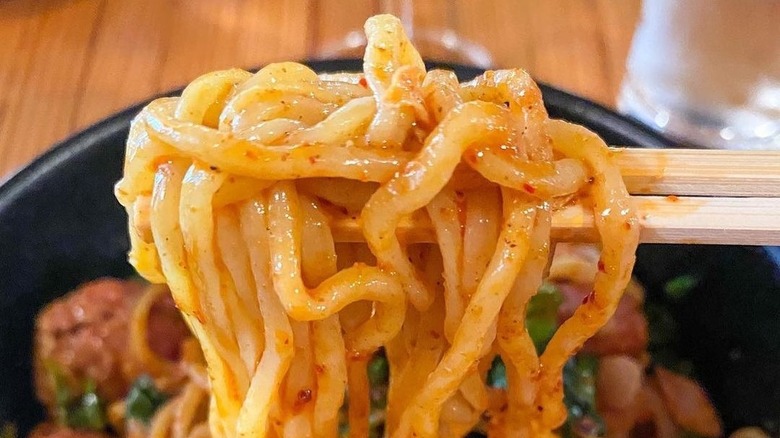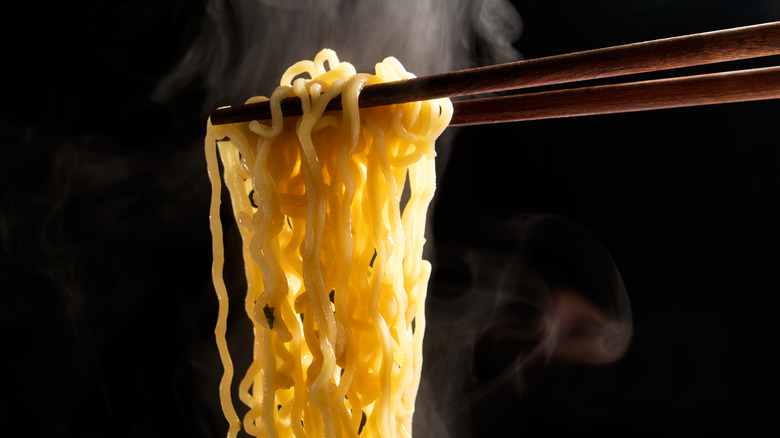What Is Mazeman And How Do You Eat It?
Ramen has long been a beloved staple of Japanese cuisine, but its lesser-known counterpart, mazeman, is just starting to gather attention worldwide. While ramen boasts widespread popularity and recognition, mazeman quietly shines with its unique characteristics and bold flavors, ready to capture the hearts of noodle lovers looking to try something new. Warming, brothy noodle soups dominate many menus for good reason, but mazeman stands out as a delicious alternative, showcasing its ingredients in a more concentrated form.
It is a completely brothless dish, though the creamy, savory sauce that coats the noodles maintains many of the punchy flavors of traditional ramen. This saucy variation not only gives mazeman a more intense flavor profile but also highlights the various textures of its components. The dish's popularity is steadily rising, with its rich history, versatility, and mouthwatering appeal making it worthy of exploration and appreciation. Read on to discover everything about this savory dish and how to enjoy it one bowl at a time.
What is mazeman?
Mazeman is a savory Japanese noodle dish characterized by wider noodles that carry a bite, tossed in a flavorful sauce or seasoning. Unlike traditional ramen which swims in a broth-based soup, mazeman is served with an umami-rich tare instead. The tare, or sauce, is typically made with ingredients such as soy sauce, rice vinegar, miso, and sesame oil. There's also often the addition of a little heat from chili paste or flakes. The name "mazeman" translates to "mixed noodles" in Japanese, reflecting the dish's preparation which entails thoroughly mixing the noodles with sauce before serving.
The toppings also play a crucial role in this tasty noodle dish. It's typically made with spicy seasoned ground pork and topped with creamy egg yolks, chopped chives or green onions, and sheets of nori seaweed, though there is plenty of room for customization and creativity. Experimenting with different sauces, toppings, and seasonings to craft unique interpretations of the dish can add new layers of flavor and create a perfect blend of savory, sweet, and umami notes. Whether enjoyed at a bustling noodle shop or prepared in the comfort of your kitchen, mazeman is all about the combination of bold flavors and satisfying textures.
Where did mazeman originate?
Curiously, the dish is sometimes also referred to as Taiwan Mazesoba though it did not originate in Taiwan. Mazeman is thought to have emerged from the bustling streets of Nagoya, Japan, in the 1950s, where its creation was heavily influenced by Taiwanese culinary traditions and flavors. Along with the lack of broth, the departure from traditional ramen toppings like chashu pork and bamboo shoots and the introduction of Taiwanese-style ground pork and egg yolks add to the dish's unique identity. Mazesoba, with its distinct fusion of flavors and techniques, first hit menus in Nagoya in 2008.
Mazeman reflects the creative ingenuity of Japanese chefs who sought to reimagine traditional noodle dishes, and this fusion of Japanese and Taiwanese influences has contributed to its rise in popularity both domestically and internationally. With its rich history and bold flavors, mazeman continues to captivate food enthusiasts as it makes its way into menus at an increasing number of Japanese restaurants worldwide.
Mazeman vs. ramen
The distinction between mazeman and its more widely recognized cousin, ramen, lies primarily in their preparation methods and flavor profiles. The essence of mazeman is its brothless base, marked by a saucy consistency. As Ivan Orkin, a renowned ramen chef, explains in an interview with Brighton Source, the thicker base used for mazeman enables the noodles to retain their texture for a longer duration, contrasting with the swift softening of ramen noodles in hot broth.
The assembly process of mazeman also diverges from that of ramen. In traditional ramen preparation, the broth and flavor base are combined right before serving the dish. Conversely, mazeman bypasses this step by incorporating the tare directly into the noodles, resulting in a dish that is seasoned with more concentrated flavors. While both recipes feature a variety of toppings and alkaline wheat noodles, mazeman often distinguishes itself with the inclusion of a raw egg yolk or an onsen tamago (a Japanese soft-cooked egg), instead of the soft or hard-boiled egg seen in ramen.
Mazeman vs. abura soba
Often compared to abura soba, another brothless noodle dish, mazeman offers distinct characteristics thanks to a more robust sauce, which results in a heartier and more indulgent eating experience. Abura soba, on the other hand, tends to have a lighter sauce that isn't as creamy. Additionally, mazeman often incorporates a wider variety of toppings and ingredients, allowing for greater customization and flavor experimentation.
Abura soba consists of boiled noodles and assorted toppings over a soy sauce-based tare. To ensure proper seasoning, diners must thoroughly blend the noodles with the tare before consumption. This dish allows for customization, with the option to add chili oil and vinegar to taste. In contrast, mazeman is served with the sauce already incorporated into the noodles, fully coating them with punchy Taiwanese-inspired flavors.
Despite their different approaches, abura soba and mazeman also share some commonalities, such as the use of thick noodles. These thicker noodles tend to stick together when they cool down, which means both dishes benefit from being stirred while hot to maintain optimal consistency and flavor.
How is mazeman made?
While the exact recipe for mazeman can vary depending on preferences and regional variations, the basic method of cooking the noodles and mixing them with a sauce remains consistent. The first step is to prepare thick wheat noodles, cooking them to al dente perfection in a large pot of boiling water. While the noodles are bubbling, the spicy pork topping can be made. Ground pork is fried with seasonings such as soy sauce, garlic, chili, mirin, and ginger until browned and aromatic.
The drained noodles are then tossed in a flavorful sauce mixture, which typically includes soy sauce, sesame oil, garlic, chili paste, and sake to create a rich, umami-packed coating for the noodles. The final step is to garnish the dish with those all-important toppings. This is the most versatile aspect of the dish, though common garnishes include chopped chives and green onions, bonito flakes, nori seaweed, and a classic gooey egg yolk. The result is a luscious flavor-packed dish that's served hot and ready to enjoy.
How to eat mazeman
Mazeman offers a hearty and satisfying dining experience. Since the noodles tend to be served ready-combined with the sauce, each strand is perfectly coated with savory goodness. However, you can continue to mix the dish as you eat it to keep redistributing those flavors and maintain the saucy texture.
Chopsticks are the traditional utensil of choice for navigating the tangle of noodles and toppings, though no judgment if you prefer to stick with a fork. Take a moment to appreciate the enticing aromas wafting from the bowl, then it's time to embrace the slurp — the signature sound of enjoyment in Japanese cuisine. In his interview with Brighton Source, chef Ivan Orkin shares, "I think people crave ramen because a lot of styles are very fun to eat. They're explosive and flavourful, and mazemen is like ramen, it's slurpy and noisy and messy and it's still very similar in the eating experience." It seems that losing the broth doesn't remove what we love about eating traditional ramen.
With mazeman, you might find that you finish eating the noodles before you have worked your way through the array of toppings. If this happens, there's an easy solution. After finishing the noodles, you can enhance the remaining ingredients in the bowl by incorporating steamed white rice, known as oi-meshi in Japanese. This helps to soak up any remaining sauce and provides another delicious starchy base for the leftover toppings.
What does it taste like?
One of the defining characteristics of mazeman is its thick, flavorful sauce, typically crafted from a liquid tare. The key flavors of the tare tend to be garlic, soy sauce, and chili to give it some heat. This savory sauce coats each noodle strand, with some people likening the result to the delicious saucy pasta dishes found in Italian cuisine. The thicker noodles are preferred as they withstand the robust flavors of the sauce and toppings. Mazeman embodies the essence of Japanese cuisine while incorporating elements reminiscent of Italian pasta dishes. In an interview with Edible Manhattan, renowned ramen chef Nakamura aptly describes the dish as "totally like pasta," emphasizing its resemblance to the beloved Italian staple.
The spicy ground pork that tops the noodles is also packed with flavor, often seasoned with garlic, chili, ginger, sesame, and sake. The pork and noodle base of mazeman offers a versatile canvas for adaptation. There's a huge variety of complementary toppings from the classics to the more unusual. Popular garnishes such as a raw egg yolk and crisp green onions add depth and richness to the dish, while more inventive additions like spicy eggplant or seafood offer unexpected bursts of flavor. Each variation gives the dish a unique take, while the hearty noodle base and savory sauce remain a mouthwatering constant.
Different variations of mazeman
Mazeman boasts a wide array of variations that showcase the creativity and innovation of chefs around the world. In his New York City restaurant Ivan Ramen, chef Ivan Orkin features a range of mazeman dishes on the menu. The Japan Times describes his Spicy Chili Hiyashi Mazeman as having a spicy tomato sauce with ground peanuts, paired with chicken and thinly sliced cucumber. This is certainly a twist on the classic soy sauce and garlic-based sauce and ground pork topping.
Another way to switch things up from the classic pork topping is by incorporating seafood, as showcased in Teiken Ramen Channel's Sweet and Spicy Seafood Mazeman. This take on the noodle dish maintains the signature sweet and spicy flavors with a sauce made from fiery Raiyu chili oil, savory shoyu, and smoky bonito fish flakes. Slices of fresh salmon sashimi and sheets of nori seaweed top off the saucy noodles.
If you prefer a more veggie-centric dish, this mazeman recipe by Andrew Le of The Pig and The Lady replaces pork with a colorful array of plant-based toppings like mustard greens and cherry tomatoes. The sauce is bursting with savory and aromatic flavors, featuring ingredients like lemongrass, ginger, peanut butter, and fish sauce. It's another take on the classic that still offers a rich and complex taste experience.
Is it easy to make at home?
Although mazeman is fast becoming a staple on Japanese restaurant menus worldwide, it's also surprisingly easy to whip up at home. The three key components are tare (or sauce), noodles, and the ground pork mixture. Once you've mastered making these, you're on your way to building a delicious, authentic mazeman.
Making the savory tare consists of simply mixing the ingredients such as soy sauce, rice vinegar, garlic, and chili paste in a bowl — so this part of the recipe is pretty foolproof. If you'd like to infuse the sauce with aromatics like lemongrass and onion, you may need to spend a little extra time heating the ingredients in a saucepan. When it comes to the noodles, it's a simple case of boiling them in a pot of water. Getting the cooking time right is essential to achieving the perfect chewy texture, so make sure to follow the instructions on the packaging closely.
For the seasoned pork, it's easy to fry up the ground meat in a pan with all the extra flavor boosters like garlic, ginger, and chili. Then, all that's left is to thoroughly toss the noodles in the flavorsome sauce and assemble everything in a bowl with your toppings of choice.
What restaurants serve mazeman?
In the United States, mazeman has found a dedicated following among ramen enthusiasts, with several restaurants across the country offering interpretations of this beloved dish. At Ivan Ramen in New York City, the mazeman offerings include creative combinations like chili eggplant or triple garlic triple pork, proving popular with their bold flavors and hearty textures.
Another standout restaurant is Mogu Mogu, with three locations in California. Known for its commitment to authenticity and innovation, Mogu Mogu offers a range of mazeman options, from classic pork to flavors like miso and curry, as well as more fusion styles like cheesy mazeman. With so many choices for both meat-eaters and vegetarians, it's a firm favorite among noodle aficionados.
In Washington D.C., Toki Underground is a must-visit restaurant for mazeman lovers. Among the eatery's creations is the famous shrimp mazeman, mouthwateringly described as containing a sweet soy sauce, fried shrimp, soft egg, scallions, pickles, and fried shallots. Other options include pork belly, chicken, and mushroom mazeman.
Health benefits of mazeman
While perhaps regarded as more of a hearty and indulgent dish, mazeman offers several surprising health benefits thanks to its diverse array of ingredients. Let's start with the hero of the dish — noodles. Typically made from wheat, these offer a great source of dietary fiber. Fiber aids in digestion, promotes bowel regularity, and helps to regulate blood sugar levels. It also contributes to a feeling of fullness, making mazeman a satisfying and nutritious meal choice. Mazeman noodles are also often made fresh in Japanese restaurants, without the addition of unwanted chemicals and preservatives that you might find in shop-bought instant noodles.
When it comes to ground pork, it's not just about that delicious savory taste. Pork is packed with protein, which is essential for muscle growth and repair. If you opt to add a golden egg yolk topping, even better. As well as providing an extra protein boost, eggs are loaded with essential vitamins and minerals like vitamin D and B12, vital for bone health and immune function.
But what about that umami-packed sauce? Garlic and ginger don't only provide punchy flavors; they bring potent anti-inflammatory properties to the mix, keeping your body in balance and potentially lowering the risk of chronic diseases. And let's not forget that medley of toppings. Adding veggies such as green onions, eggplant, and leafy greens delivers a dose of vitamins, minerals, and antioxidants — supporting your overall health and wellbeing.
How to store and reheat leftover mazeman
Whether it's takeout or homemade, storing leftover mazeman to finish later is no problem. You'll want to store the noodles and pork separately from the other toppings and skip the raw egg which is best enjoyed fresh. Allow everything to cool to room temperature before transferring the leftover mazeman into an airtight container and placing it in the fridge, where it should keep well for up to two days.
When you're ready to enjoy the rest, reheat it thoroughly before serving. You can do this by transferring the desired portion into a microwave-safe dish, adding a splash of water, and heating it in the microwave until warmed through. Give it a good stir halfway through to ensure even cooking. Alternatively, you can reheat it on the stovetop in a saucepan over medium heat, stirring occasionally until piping hot.
Unfortunately, freezing is not the best option when it comes to noodles, as it can cause an unwanted soggy texture after reheating. Luckily, mazeman leftovers are pretty hard to resist so they likely won't be around for more than a few days.
